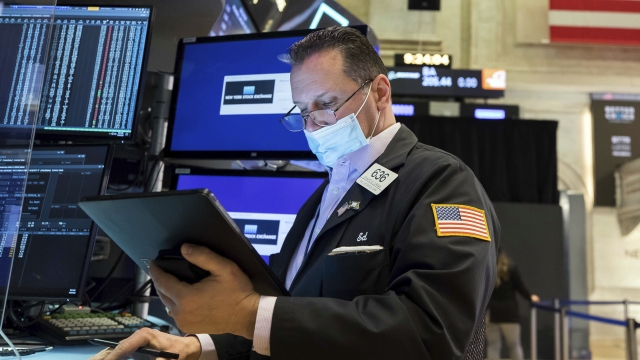Stocks recovered from big early losses Monday as investors jumped in before the closing bell.
The Dow Jones Industrial Average swung 1,217 points and closed up 0.3% after dropping 1,000 points as investors anticipated inflation-fighting measures from the Federal Reserve and fretted over possible conflict between Russia and Ukraine.
Benchmark indexes flirted with near 4-month lows as the market readies for the Fed to raise interest rates to tame inflation, which is at its highest level in nearly four decades. Retailers notched some of the biggest gains: Gap jumped nearly 8%.
The stock market extended its three-week decline and put the benchmark S&P 500 on track for a so-called correction — a drop of 10% or more from its most recent high. The price of oil and Bitcoin fell, and so did the yield on 10-year Treasury notes, a sign of investor concern about the economy.
The steady decline in stock prices has come as the Fed has signaled its readiness to begin raising its benchmark short-term interest rate in 2022 to try to tame inflation, which is at its highest level in nearly four decades.
The Fed's short-term rate has been pegged near zero since the pandemic hit the global economy in 2020 and that has fueled borrowing and spending by consumers and businesses.
But rising prices at supermarkets, car lots and gas stations are raising concerns that consumers will pare back spending to limit the pressure on their budgets. Companies have warned that supply-chain problems and higher raw materials costs could crimp their profits.
The Fed has kept downward pressure on longer-term interest rates by buying trillions of dollars worth of government and corporate bonds, but those emergency purchases are scheduled to end in March. Nudging rates higher is intended to help slow economic growth and the rate of inflation.
"There's a short-term panic and part of that is the high level of uncertainty around what the Fed is going to do," said Sylvia Jablonski, chief investment officer at Defiance ETFs.
Jablonski said investors haven't rushed in to buy stocks during the recent decline. "Buying the dip" has been a hallmark of market optimism for much of the period following the financial crisis in 2008-2009.
Technology stocks led the decline. Higher rates make shares in high-flying tech companies and other expensive growth stocks relatively less attractive.
Apple fell 2.6% and Microsoft shed 2%. Nvidia fell 4.7% and is now down more than 24% in January. The technology sector is by far the biggest in the S&P 500 and is now down more than 12% so far this year.
The selloff has extended to cryptocurrencies. Bitcoin fell as low as $33,000 overnight but had rallied back above $36,000 in the early afternoon. Still, the digital currency is far below the high of more than $68,000 it hit in November.
The market is waiting to hear from Federal Reserve policymakers after their latest meeting ends Wednesday. Some economists have expressed concern that the Fed is already moving too late to combat high inflation.
Other economists say they worry that the Fed may act too aggressively. They argue that numerous rate hikes would risk causing a recession and wouldn't slow inflation in any case. In this view, high prices mostly reflect snarled supply chains that the Fed's rate hikes are powerless to cure.
When the Fed boosts its short-term rate, it tends to make borrowing more expensive for consumers and businesses, slowing the economy with the intent of reducing inflation. That could reduce company earnings, which tend to dictate stock prices over the long term.
The Fed's benchmark short-term interest rate is currently in a range of 0% to 0.25%. Investors now see a nearly 65% chance that the Fed will raise the rate four times by the end of the year, up from a 35% chance a month ago, according to CME Group's Fed Watch tool.
Wall Street anticipates the first increase in interest rates in March. In a note to clients over the weekend, Goldman Sachs forecast four rate hikes this year but said the Fed could be forced to raise rates five times or more if supply chain problems and wage growth keep inflation at elevated levels.
Investors are also keeping an eye on developments in Ukraine. Tensions soared Monday between Russia and the West over concerns that Moscow is planning to invade Ukraine, with NATO outlining potential troop and ship deployments.
Europe's STOXX 600 index closed down 3.6% on concerns about Fed tightening and worries about the situation around Ukraine. The Russian ruble has also fallen after U.S. President Joe Biden indicated that in the event of a Russian invasion, the U.S. could block Russian banks from access to dollars or impose other sanctions.
Bond yields edged lower. The yield on the 10-year Treasury fell to 1.72% from 1.74% late Friday. Falling yields weighed on banks, which rely on higher yields to charge more lucrative interest on loans. Bank of America fell 3%.
Investors are monitoring the latest round of corporate earnings, in part, to gauge how companies are dealing with higher prices and what they plan to do as inflation continues pressuring operations.
On Tuesday, American Express, Johnson & Johnson, and Microsoft report results. Boeing and Tesla report their results on Wednesday. McDonald's, Southwest Airlines and Apple report results on Thursday.
This story was originally reported by The Associated Press and Newsy.




![SNG_Digital_Ad_480x360_CTA[13].jpg](https://ewscripps.brightspotcdn.com/7d/db/0b14063144e881c22c4592637e0d/sng-digital-ad-480x360-cta13.jpg)